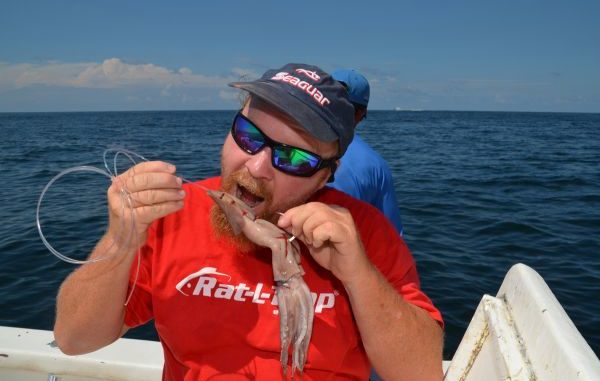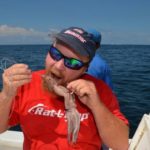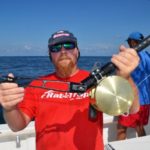
Fishing for swordfish ain’t like perch fishing. Nothing is tiny and delicate.
Everything is big and strong — and expensive.
Start with the reel. It’s a Shimano Tiagra 80W.
“It’s the most-dependable offshore reel made, and it has plenty of line capacity,” Marvel said.
It costs $850.
His rod is custom built from a 50- to 80-pound-rated 6-foot Seeker composite rod blank by Jeff Vadakin in Daphne, Ala.
“The most-important thing about our sword rods are the Winthrop roller guides,” Marvel noted. “They do not let the thin line we use slip between the roller and the frame of the guide.”
The butt of the rod is adjustable, allowing it to be used straight or bent.
Ordinarily, the rod is used in the bent position, but when a fish is up near the surface and running, straightening the butt allows the fisherman to keep a bend in the rod without having to lean back as far as he would with a bent butt.
A rod like it costs $1,300 to $1,600.
The reel is spooled first with 1,000 yards of 130-pound-test Jerry Brown Line One Hollow Core Spectra Braided line ($225), followed by 3,000 yards of 80-pound high-visibility yellow (Tweety Bird-yellow, is how Fayard described it) PowerPro braided line ($260).
The line being high-visibility is important because swordfish bites are subtle, so the men have to watch the line like hawks.
To this line, Marvel and Fayard add a wind-on leader separated from the PowerPro by a 130-pound Spro Ball Bearing Swivel.
The leader is made by inserting 4 feet of a 75-length of 130-pound-test Seaguar fluorocarbon line into a 5-foot length of hollow-core Spectra. They whip the connecting point with 30-pound Spectra in a Super Glued square knot.
On the other end of the fluorocarbon comes a 300-pound Spro Ball Bearing Swivel, followed by 2 feet of 300-pound-test Seaguar fluorocarbon that ends in a 9/0 or 10/0 Mustad 7691 J hook.
Swivels are usually attached to the line with crimped sleeves, but they also can be tied on with uni knots. Hooks are usually either snelled or crimped on the line, but also can be uni-knotted.
A D-loop is placed about halfway up the leader. A longline snap is used to attach a weight up to 4 pounds on 1½ feet of 300-pound-test line to the loop.
The stronger the current is, the heavier the weight required. The weight keeps the bait at the desired fishing depth once the main weight has taken it down and detached.
Two small Diamond LED fishing lights are rubber banded to the leader approximately 10 feet above the hook. It’s dark in 1,500 feet of water, even at mid-day.
The lights come in red, yellow, green or clear.
“I really don’t think that light color matters much, although I think white is least effective,” Marvel opined.
Squid is the bait of choice for swordfishing. Marvel buys the largest fresh squid he can find at New Orleans Asian markets. These he bags in zipper bags and freezes for later.
The squid are sewn onto the hooks with 50-pound rigging thread made for rigging baits. Sewing allows the bait to handle a lot of abuse, keeping it on the hook and looking natural.
“Do you want to reel up and check your bait often?” Marvel asked. “That’s 500 cranks on the big reel.”
The last step is attaching the detachable main weight to the baited hook. Marvel refused to allow a photo shot or a written description of the heavy, homemade contraption.
“I have to leave something for others to figure out,” he said with a grin.
Needless to say, it detached from the hook flawlessly every time with several swift jerks of the rod.

